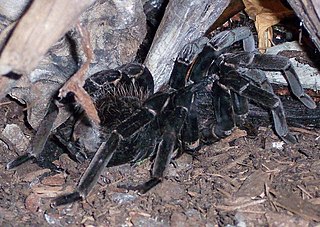
Simón José Antonio de la Santísima Trinidad Bolívar y Palacios was a Venezuelan military and political leader who led what are currently the countries of Colombia, Venezuela, Ecuador, Peru, Panama and Bolivia to independence from the Spanish Empire. He is known colloquially as El Libertador, or the Liberator of America.

Pamphobeteus is a genus of tarantulas that was first described by Reginald Innes Pocock in 1901. It includes some of the largest spiders in the world. They are found in South America, including the countries of Peru, Bolivia, Ecuador, Brazil, Colombia and Panama.

Psalmopoeus is a genus of the family Theraphosidae containing various species of tarantulas. The genus is native to Trinidad and Tobago, Colombia, Ecuador, Venezuela, Guyana, Brazil, Belize, Panama, Nicaragua, Costa Rica, Mexico, Guatemala and Honduras. All of these tarantulas are arboreal in nature, Psalmopoeus victori being the first arboreal tarantula of Mexico.

Tarantulas comprise a group of large and often hairy spiders of the family Theraphosidae. As of August 2022, 1,040 species have been identified, with 156 genera. The term "tarantula" is usually used to describe members of the family Theraphosidae, although many other members of the same infraorder (Mygalomorphae) are commonly referred to as "tarantulas" or "false tarantulas". Some of the more common species have become popular in the exotic pet trade. Many New World species kept as pets have setae known as urticating hairs that can cause irritation to the skin, and in extreme cases, cause damage to the eyes.

Neischnocolus is a genus of spiders in the family Theraphosidae. It was first described in 1925 by Petrunkevitch. The genus Ami was separately described in 2008, but was later discovered to be a junior synonym of Neischnocolus. Species are native to Central America and northern South America.

Cyriocosmus is a genus of tarantulas that was first described by Eugène Louis Simon in 1903. They are small to medium spiders, with a bicolored or one same color carapace.
Cyclosternum is a genus of tarantulas that was first described by Anton Ausserer in 1871.
The Ischnocolinae are a problematic subfamily of tarantulas. In 1892, Eugène Simon based the group, which he noted was only weakly homogeneous, on the presence of divided tarsal scopulae. This feature was later considered to be plesiomorphic, and both morphological and molecular phylogenetic studies have shown that, as traditionally circumscribed, the subfamily is not monophyletic. A much more narrowly defined Ischnocolinae sensu stricto was proposed in 2014. One of the authors of that proposal subsequently said that no further taxonomic changes should be considered until there had been a more comprehensive sampling of the subfamily. As of January 2021, the status of the Ischnocolinae remains unresolved.

Holothele is a genus of tarantulas that was first described by Ferdinand Anton Franz Karsch in 1879. Originally placed with the curtain-web spiders, it was transferred to the tarantulas in 1980.
Tmesiphantes is a genus of Brazilian tarantulas in the subfamily Theraphosinae that was first described by Eugène Louis Simon in 1892. The genera Magulla and Melloleitaoina were brought into synonymy in 2019.
Trichopelma is a genus of South American and Caribbean tarantulas first described by Eugène Simon in 1888.

Hapalopus is a genus of tarantulas that was first described by Anton Ausserer in 1875.
Schismatothele is a genus of South American tarantulas that was first described by Ferdinand Anton Franz Karsch in 1879.

Xenesthis is a genus of tarantulas that was first described by Eugène Louis Simon in 1891. As of May 2020 it contains four species, found in Colombia and Venezuela, though it was previously considered to be found in Panama.

Neoholothele is a genus of tarantula, first described in 2015 by Guadanucci & Weinmann. As of August 2022, it contains 2 species Neoholothele fasciaaurinigra and Neoholothele incei, the latter being the type species. They are named after the prefix "neo" from the greek word for new, and the genus Holothele.
Rick C. West is a Canadian arachnologist and an expert on the taxonomy of tarantula spiders. West was born in Victoria, British Columbia. He has been interested in spiders since childhood, and collected his first tarantula, Aphonopelma eutylenum, at the age of 13. He worked primarily as a Chief Constable for a local Animal Humane Society, but also have been involved with the collecting, breeding, rearing and photography of theraphosid spiders. West has traveled to over 27 countries to document and study them in their environment, has been a host, presenter and co-producer in several tarantula documentaries and has also described several genera and species.
Spinosatibiapalpus is a genus of tarantulas erected by Gabriel and Sherwood in 2020 for a newly discovered species and two other previously described species bearing a unique palpal bulb morphology. The name is a reference to the spines found on the fourth section of the pedipalp in adult males. This distinctive feature was also found in Pseudhapalopus species, but because it is never mentioned in the original description of that genus, Gabriel and Sherwood called into question the validity of Pseudohapalopus, and moved all its species except P. aculeatus, known only from a single male found in Bolivia in 1907. It is impossible to place P. aculeatus because the holotype was destroyed when the museum housing it was bombed during World War II, and it has been declared as nomen dubium.









